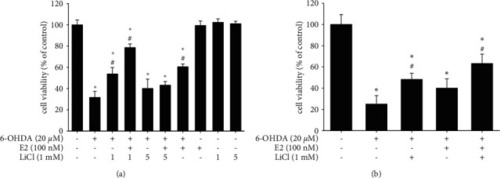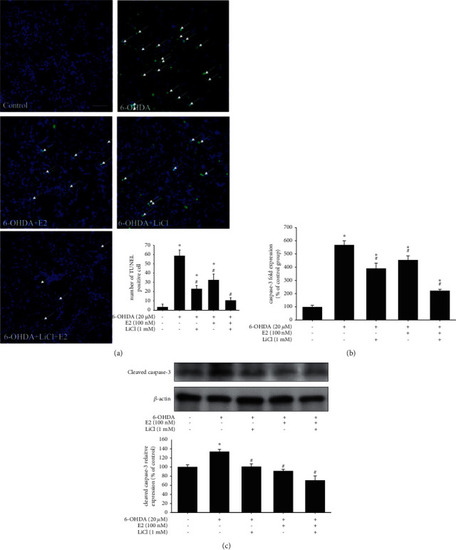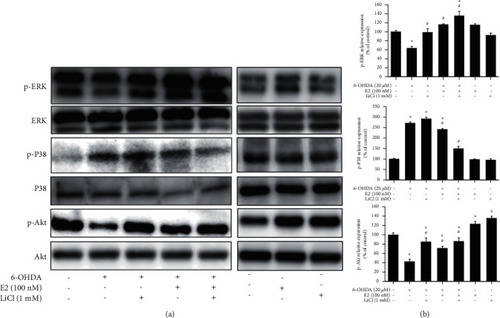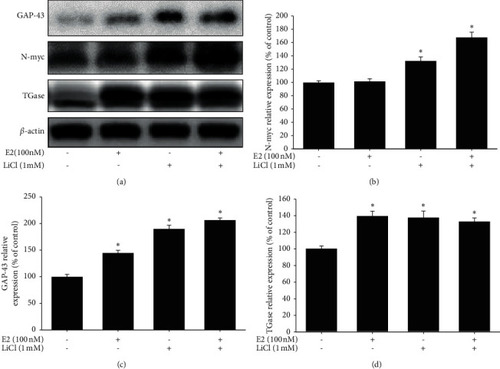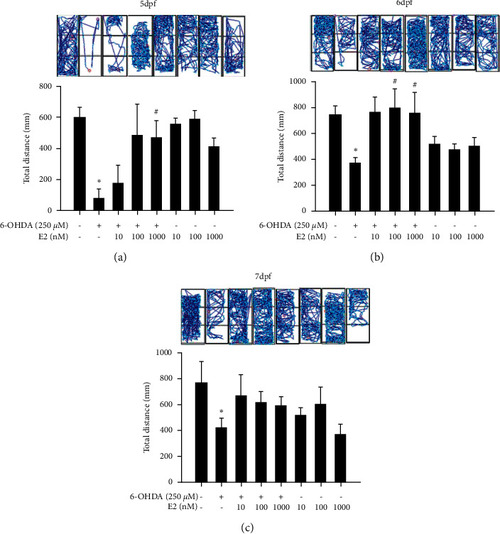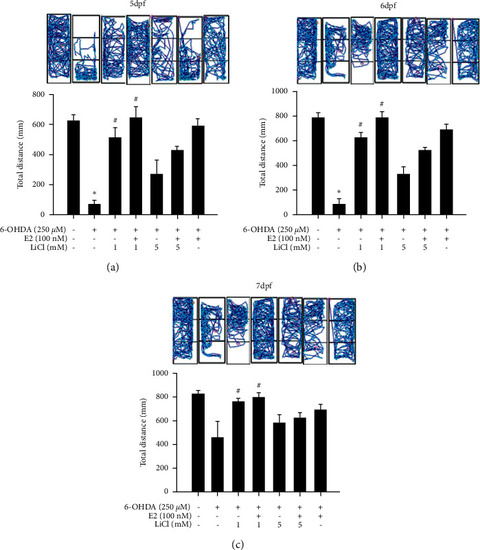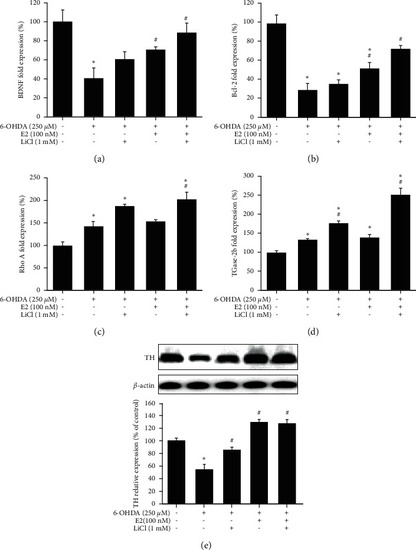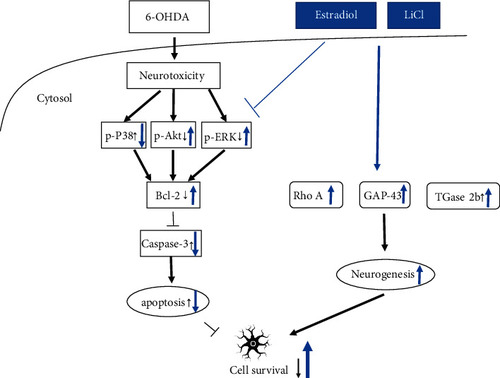- Title
-
Neuroprotective Effects of Estradiol plus Lithium Chloride via Anti-Apoptosis and Neurogenesis Pathway in In Vitro and In Vivo Parkinson's Disease Models
- Authors
- Lee, Y.S., Feng, C.W., Peng, M.Y., Chan, T.F., Chen, Y.C.
- Source
- Full text @ Parkinsons Dis
|
Effect of estradiol (E2) plus lithium chloride (LiCl) on 6-OHDA-induced SH-SY5Y cell death. (a) The SH-SY5Y cells were pretreated with 1 or 5 mM LiCl for 1 hr in the absence or presence of 100 nM E2 and then challenged with 20 μM 6-OHDA for 16 hr. Cell viability of control, 6-OHDA, 6-OHDA plus 1 mM LiCl, 6-OHDA plus 1 mM LiCl and 100 nM E2, 6-OHDA plus 5 mM LiCl, 6-OHDA plus 5 mM LiCl and 100 nM E2, 6-OHDA plus 100 nM E2, 100 nM E2 alone, 1 mM LiCl alone and 5 mM LiCl alone. Cell viability was assessed by AlamarBlue. (b) The SH-SY5Y cells were pretreated with 1 mM LiCl for 1 hr in the absence or presence of 100 nM of E2 and then challenged with 20 μM 6-OHDA for 16 hr. Cell viability of control, 6-OHDA, 6-OHDA plus 1 mM LiCl, 6-OHDA plus 1 mM LiCl and 100 nM E2, and 6-OHDA plus 100 nM E2 by trypan blue. The value corresponds to the mean ± SEM of five independent experiments that have been done in triplicate (n = 15). ∗p < 0.05 compared with the control group; #p < 0.05 compared with the 6-OHDA group. |
|
The anti-apoptosis effect of E2 plus lithium chloride on 6-OHDA-induced damage in SH-SY5Y cells. (a) The SH-SY5Y cells were pretreated with 1 mM LiCl for 1 hr in the absence or presence of 100 nM E2 and then challenged with 20 μM 6-OHDA for 8 hr. Apoptotic effect of control, 6-OHDA, 6-OHDA plus 1 mM LiCl, 6-OHDA plus 1 mM LiCl, and 100 nM E2 and 6-OHDA plus 100 nM E2 groups. TUNEL staining was performed, and white arrows represent apoptotic cells (scale bar, 100 μm). The quantification result of apoptotic cells is shown. (b) The SH-SY5Y cells were pretreated with 1 mM LiCl for 1 hr in the absence or presence of 100 nM E2 and then challenged with 20 μM 6-OHDA for 8 hr in control, 6-OHDA, 6-OHDA plus 1 mM LiCl, 6-OHDA plus 1 mM LiCl, and 100 nM E2 and 6-OHDA plus 100 nM E2 groups. (c) The SH-SY5Y cells were pretreated with 1 mM LiCl for 1 hr in the absence or presence of 100 nM E2 and then challenged with 20 μM 6-OHDA for 8 hr in control, 6-OHDA, 6-OHDA plus 1 mM LiCl, 6-OHDA plus 1 mM LiCl, and 100 nM E2 and 6-OHDA plus 100 nM E2 groups. Western blotting of cleaved caspase-3 protein and quantification of each group are shown. β-Actin was used as an internal control for normalization. The value corresponds to the mean ± SEM of three independent experiments that have been done in triplicate (n = 9). ∗p < 0.05 compared with the control group; #p < 0.05 compared with the 6-OHDA group. |
|
Effect of lithium chloride and E2 on 6-OHDA-induced downregulation of phospho-extracellular signal-regulated kinases (p-ERK), phospho-Akt (p-Akt), and p-P38 in SH-SY5Y cells. (a) SH-SY5Y cells were pretreated with 1 mM LiCl for 1 hr in the absence or presence of 100 nM E2 and then challenged with 20 μM 6-OHDA for 1 hr. Western blotting for p-ERK, p-Akt, and p-P38 of the control, 6-OHDA, 6-OHDA plus 1 mM LiCl, 6-OHDA plus 100 nM E2, 6-OHDA plus 1 mM LiCl and 100 nM E2, 100 nM E2 alone and 1 mM LiCl alone groups. (b) The quantification results of p-ERK, p-Akt, and p-P38 relative density are shown. The value corresponds to the mean ± SEM of three independent experiments that have been done in triplicate (n = 9). ∗p < 0.05 compared with the control group; #p < 0.05 compared with the 6-OHDA group. |
|
Effect of lithium chloride and estradiol on growth associated protein 43 (GAP-43), N-myc, and TGase in SH-SY5Y cells. (a) SH-SY5Y cells were co-treated with 1 mM LiCl in the absence or presence of 100 nM E2 for 24 hr. Western blotting for GAP-43 and N-myc of the control, 1 mM LiCl, 100 nM E2 and 1 mM LiCl plus 100 nM E2 groups. (b) The quantification result of GAP-43 relative density is shown. (c) The quantification result of TGase relative density is shown. (d) The quantification results of N-myc relative density are shown. β-Actin was used as an internal control for normalization. The value corresponds to the mean ± SEM of three independent experiments that have been done in triplicate (n = 9). ∗p < 0.05 compared with the control group; #p < 0.05 compared with the 6-OHDA group. |
|
Effect of estradiol on 6-OHDA-induced locomotor deficit in the zebrafish PD model. Zebrafish were pretreated with 10, 100, and 1000 nM E2 from 9 hpf to 5 dpf and then challenged with 250 μM 6-OHDA from 2 to 5 dpf. The locomotor behavior was measured at 5, 6, and 7 dpf of the control, 6-OHDA, 6-OHDA plus 10 nM E2, 6-OHDA plus 100 nM E2, 6-OHDA plus 1000 nM E2, 10 nM E2, 100 nM E2, and 1000 nM E2 groups. The upper panel demonstrates a representative swimming pattern, and the lower panel shows the average total swimming distance. The value corresponds to the mean ± SEM of two independent experiments that have been done in octuplicate (n = 16). ∗p < 0.05 compared with the control group; #p < 0.05 compared with the 6-OHDA group. |
|
Effect of estradiol plus lithium chloride on 6-OHDA-induced locomotor deficit in the zebrafish PD model. Zebrafish were pretreated 1 or 5 mM LiCl in the absence or presence of 100 nM E2 from 9 hpf to 5 dpf and then challenged with 250 μM 6-OHDA from 2 to 5 dpf of the the control, 6-OHDA, 6-OHDA plus 1 mM LiCl, 6-OHDA plus 100 nM E2, and 6-OHDA plus 1 mM LiCl and 100 nM E2 groups. The upper panel demonstrates a representative swimming pattern, and the lower panel shows the average total swimming distance. The value corresponds to the mean ± SEM of two independent experiments that have been done in octuplicate (n = 16). ∗p < 0.05 compared with the control group; #p < 0.05 compared with the 6-OHDA group. |
|
Neuroprotective effect of lithium chloride plus estradiol on the 6-OHDA-induced zebrafish PD model. (a) Zebrafish were pretreated with 1 mM LiCl (9 hpf to 5 dpf) in the absence or presence of 100 nM E2 and then challenged with 250 μM 6-OHDA (2 to 5 dpf). Quantitative PCR of BDNF was performed. (b) Zebrafish were pretreated with 1 mM LiCl (9 hpf to 5 dpf) in the absence or presence of 100 nM E2 and then challenged with 250 μM 6-OHDA (2 to 5 dpf). Quantitative PCR of Bcl-2 was performed. (c) Zebrafish were pretreated with 1 mM LiCl (9 hpf to 5 dpf) in the absence or presence of 100 nM E2 and then challenged with 250 μM 6-OHDA (2 to 5 dpf). Quantitative PCR of Rho A was performed. (d) Zebrafish were pretreated with 1 mM LiCl (9 hpf to 5 dpf) in the absence or presence of 100 nM E2 and then challenged with 250 μM 6-OHDA (2 to 5 dpf). Quantitative PCR of TGase 2b was performed. (e) Zebrafish were pretreated with 1 mM LiCl (9 hpf to 5 dpf) in the absence or presence of 100 nM E2 and then challenged with 250 μM 6-OHDA (2 to 5 dpf). Western blotting of TH was performed. β-Actin was used as an internal control for normalization. The value corresponds to the mean ± SEM of three independent experiments that have been done in triplicate (n = 9). ∗p < 0.05 compared with the control group; #p < 0.05 compared with the 6-OHDA group. |
|
Schematic diagram of lithium chloride (LiCl) plus estradiol (E2) in 6-OHDA-induced neuronal death. 6-OHDA could induce cell apoptosis through increasing of p-Akt and p-ERK expression, decreasing p-P38, and further modulating the downstream apoptotic proteins, such as Bcl-2 and caspase-3. Our studies demonstrated that the co-treatment of LiCl and E2 could enhance neurogenesis via increasing Rho A, GAP-43, and TGase-2b protein expression. Besides, co-treatment of LiCl and E2 attenuated cell apoptosis through reversing 6-OHDA-induced downregulation of p-Akt, p-ERK and attenuating 6-OHDA-induced upregulation of p-P38 protein expression. The downstream cascade was also modulated, such as Bcl-2 and caspase-3. The 6-OHDA-induced upregulating Bcl-2 expression was reversed by the co-treatment of LiCl plus E2 and 6-OHDA-induced upregulating of caspase-3 expression was also attenuated. The neuroprotective effect of LiCl plus E2 significantly protected dopamine neurons against damage. |

